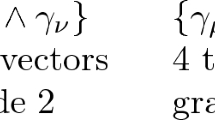Abstract
It is shown that Einstein's vacuum field equations (respectively the conformal vacuum field equations) in a frame formalism imply a symmetric hyperbolic system of “reduced” propagation equations for any choice of coordinate system and frame field (and conformal factor). Certain freely specifiable “gauge source” functions occurring in the reduced equations reflect the choice of gauge. Together with the initial data they determine the gauge uniquely. Their choice does not affect the isometry class (conformal class) of a solution of an initial value problem. By the same method symmetric hyperbolic propagation equations are obtained from other gauge field equations, irrespective of the gauge. Using the concept of source functions one finds that Einstein's field equation, considered as second order equations for the metric coefficients, are of wave equation type in any coordinate system.
Similar content being viewed by others
References
Friedrich, H.: The asymptotic characteristic initial value problem for Einstein's vacuum field equations as an initial value problem for a first-order quasilinear symmetric hyperbolic system. Proc. R. Soc. (London) A378, 401–421 (1981)
Friedrich, H.: On the regular and the asymptotic characteristic initial value problem for Einstein's vacuum field equations. Proc. R. Soc. (London) A375, 169–184 (1981)
Friedrich, H.: Cauchy problems for the conformal vacuum field equations in general relativity. Commun. Math. Phys.91, 445–472 (1983)
Friedrichs, K. O.: Symmetric hyperbolic linear differential equations. Commun. Pure Appl. Math.8, 345–392 (1954)
Courant, R., Hilbert, D.: Methods of mathematical physics, Vol. II. New York: Interscience 1962
Kato, T.: The Cauchy problem for quasi-linear symmetric hyperbolic systems. Arch. Ration. Mech. Anal.58, 181–205 (1975)
Friedrich, H.: On purely radiative space-times, preprint, Hamburg 1985.
Friedrich, H.: On some (con-) formal properties of Einstein's field equations and their consequences. In: Proceedings of the conference on “Asymptotic behaviour of mass and space-time geometry.” Corvallis 1983, Flaherty, F. J., ed. Berlin Heidelberg, New York: Springer 1984
Lanczos, C.: Ein vereinfachendes Koordinatensystem für die Einsteinschen Gravitationsgleichungen. Phs. Z.23, 537–539 (1922)
Choquet-Bruhat, Y.: Théorème d'existence pour certain systèmes d'èquations aux derivées partielles non linéaires. Acta Math.88, 141–225 (1952)
Mizohata, S.: The theory of partial differential equations. Cambridge: Cambridge University Press 1973
Author information
Authors and Affiliations
Additional information
Communicated by S. W. Hawking
Work supported by a Heisenberg-Fellowship of the Deutsche Forschungsgemeinschaft
Rights and permissions
About this article
Cite this article
Friedrich, H. On the hyperbolicity of Einstein's and other gauge field equations. Commun.Math. Phys. 100, 525–543 (1985). https://doi.org/10.1007/BF01217728
Received:
Issue Date:
DOI: https://doi.org/10.1007/BF01217728




